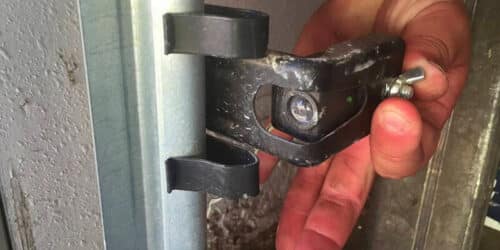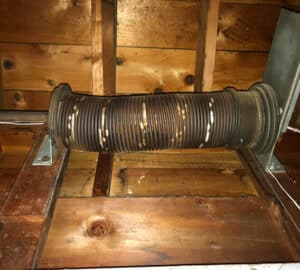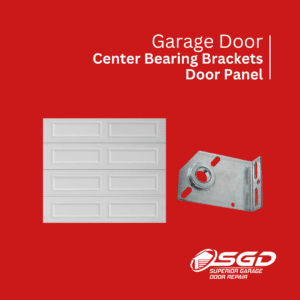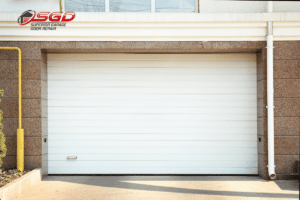Welcome to our comprehensive guide on how to align your garage door sensors. Properly aligned sensors are crucial for the safe and smooth operation of your garage door. In this article, we will walk you through the step-by-step process of aligning your garage door sensors and provide troubleshooting tips to ensure optimal performance. Whether you are experiencing misalignment issues or simply want to perform regular maintenance, this guide has got you covered.
Key Takeaways:
- Aligning your garage door sensors is essential for safe and efficient operation.
- Regular maintenance and testing will help you maintain the alignment of your sensors.
- If you encounter any alignment issues, troubleshoot using our troubleshooting tips.
- Remember to follow the step-by-step instructions for proper sensor alignment.
- Inspect your sensors, check cables and connections, and fix any misalignment issues before starting the alignment process.
Understanding Garage Door Sensors
Before we dive into the alignment process, it’s essential to understand how garage door sensors work. Garage door sensors play a critical role in ensuring your safety by detecting obstacles and preventing the door from closing if something is in the way. By understanding their function, you can appreciate the significance of aligning these sensors properly.
The primary purpose of garage door sensors is to detect objects or people in the path of the closing door, preventing accidents and injuries. They consist of two parts: the sending sensor and the receiving sensor.
Role of the Sending Sensor:
The sending sensor emits an invisible beam of infrared light towards the receiving sensor. This beam is constantly transmitted and should be received uninterrupted for the door to close safely. If there is an obstruction, the beam is disrupted, causing the door to reverse and stay open.
Role of the Receiving Sensor:
The receiving sensor is responsible for receiving the infrared beam emitted by the sending sensor. If the receiving sensor fails to detect the beam, it indicates an obstruction, and the door will not close.
To ensure the proper functioning of these sensors, it is crucial to align them correctly. When the garage door sensors are misaligned, they may not function as intended, leading to safety hazards and inconvenience. Therefore, regularly aligning the garage door sensors is essential for optimal performance.
In the next section, we will guide you through the preparation process before aligning your garage door sensors, ensuring you have a clear understanding and a smooth experience throughout the calibration process.
Preparing for Sensor Alignment
Before you begin the alignment process, it’s important to prepare properly to ensure successful results. Follow these initial steps to fix any garage door sensor misalignment:
- Inspect your sensors: Start by visually examining both the sending and receiving sensors. Look for any physical damage, dirt, or obstructions that may interfere with their alignment.
- Check cables and connections: Ensure that the cables connecting the sensors to the garage door opener are securely plugged in and free from any damage or wear. Loose or damaged cables can cause sensor misalignment.
- Identify misalignment issues: Use a level to check the alignment of both sensors. They should be perfectly parallel to each other and at the same height. If they are misaligned, you may need to adjust their positions.
By properly preparing for the sensor alignment process, you can address any potential issues and ensure a smooth and effective alignment procedure.
Step-by-Step Sensor Alignment Instructions
Proper alignment of your garage door sensors is crucial for the safe and smooth operation of your garage door. In this section, we will provide you with detailed step-by-step instructions on how to align your garage door sensors to ensure optimal performance.
- Locate the sensors: Start by identifying the sending and receiving sensors. The sending sensor is typically located on the side of the garage door track, while the receiving sensor is on the opposite side.
- Check sensor positions: Ensure that the sensors are properly positioned and securely mounted. The sending sensor should be facing the receiving sensor directly, with no obstructions in between.
- Adjust sensor height: Use a level to check the alignment of both sensors vertically. If one sensor is higher or lower than the other, adjust their positions accordingly until they are level.
- Align sensors horizontally: Once the sensors are level vertically, check their alignment horizontally. Use a string or laser level to create a straight line between the sending and receiving sensors. Adjust the sensors as needed to ensure they are perfectly aligned.
- Test the sensor alignment: After aligning the sensors, test their alignment by closing the garage door. If the sensors are properly aligned, the door should close smoothly without any interruption. If the door doesn’t close or reverses, it indicates a misalignment issue that needs to be addressed.
By following these step-by-step instructions, you can align your garage door sensors effectively, ensuring safe and efficient operation of your garage door.
Troubleshooting Sensor Alignment Issues
Sometimes, even after following the alignment instructions, you may encounter issues. In this section, we will troubleshoot common sensor alignment problems and provide solutions to ensure your garage door sensors function flawlessly.
When troubleshooting garage door sensor alignment, it’s important to start with a systematic approach. Follow these steps to uncover and resolve any alignment issues:
- Inspect the sensors: First, visually inspect both the sending and receiving sensors. Look for any obstructions, dirt, or damage that may be interfering with proper alignment. Clean the sensor lenses using a soft, lint-free cloth and check for any loose connections or damaged wires.
- Check the alignment: Next, ensure that the sensors are properly aligned. Use a level to ensure that both sensors are perfectly horizontal and facing each other. Adjust the position of the sensors as needed, making sure there is no gap between the sensor lenses.
- Test the sensor lights: After aligning the sensors, test if the indicator lights are functioning correctly. When the sensors are aligned, the indicator lights should be solid and not blinking or flickering. If the lights are not solid, check the power supply and connections.
- Inspect the safety reverse mechanism: If your garage door has a safety reverse mechanism, make sure it is working correctly. Test the door’s function by placing a small object, like a cardboard box, in the door’s path. The door should automatically reverse when it comes into contact with the object. If the door does not reverse, there may be an issue with the sensors or the safety reverse mechanism.
If the troubleshooting steps above do not resolve the garage door sensor alignment issues, it may be necessary to consult a professional technician for further assistance. They have the expertise and tools to diagnose and fix more complex alignment problems.
Remember, maintaining properly aligned garage door sensors is essential for safe and efficient operation. By identifying and troubleshooting alignment issues, you can ensure that your garage door functions flawlessly, providing you with peace of mind and convenience.
Regular Maintenance and Testing
Proper maintenance and regular testing are essential for ensuring your garage door sensors remain aligned and function effectively. By following these routine maintenance tasks and testing procedures, you can keep your garage door sensors in optimal condition.
Maintenance Tasks
To maintain the alignment of your garage door sensors, consider performing the following maintenance tasks:
- Clean the sensors: Remove any dirt, dust, or debris that may accumulate on the sensors. Use a soft, dry cloth to wipe them gently.
- Inspect the sensor brackets: Check the brackets that hold the sensors in place. Ensure they are secure and not loose.
- Examine the sensor wiring: Inspect the wiring connecting the sensors to the garage door opener. Look for any signs of wear or damage, such as frayed wires or exposed connections.
- Test the sensor lenses: Carefully examine the lenses of the sensors. Ensure they are clean and free from scratches that may interfere with proper alignment.
- Check the sensor alignment regularly: Perform visual inspections to verify that the sensors are still aligned properly. Look for any signs of misalignment, such as a noticeable gap between the sensors or one of the sensors not facing directly at the other.
Testing Procedures
In addition to regular maintenance, it’s crucial to perform periodic testing to ensure your garage door sensors are functioning correctly. Follow these testing procedures:
- Activate the garage door: Open and close the garage door using the control panel or remote to observe the sensor response.
- Observe the sensor lights: Check the indicator lights on the sensors. Both sensors should have a steady green light when the door is closed and not obstructed. If one or both lights are not illuminated or blinking, it indicates a potential alignment issue.
- Test sensor detection: Place an object, such as a box or a piece of wood, in the path of the closing door. The door should reverse immediately upon detecting the obstruction. If it continues to close without reversing, it may suggest a misalignment between the sensors.
Regular maintenance and testing will not only help you identify any misalignment issues promptly but also ensure the safety and smooth operation of your garage door.
| Maintenance Tasks | Testing Procedures |
| Clean the sensors | Activate the garage door |
| Inspect the sensor brackets | Observe the sensor lights |
| Examine the sensor wiring | Test sensor detection |
| Test the sensor lenses | |
| Check the sensor alignment regularly |
Conclusion
In conclusion, ensuring the proper alignment of your garage door sensors is crucial for the safe and efficient operation of your garage door. By following our comprehensive guide and troubleshooting tips, you will be able to maintain the alignment of your sensors and enjoy hassle-free functionality.
Remember, regular maintenance and testing are essential to avoid any potential alignment issues in the future. Take the time to inspect your sensors, check cables and connections, and perform routine maintenance tasks to keep your garage door system running smoothly.
By aligning your garage door sensors correctly and conducting regular maintenance, you can ensure the optimal performance and longevity of your garage door system. Don’t overlook this critical aspect of garage door care, and enjoy the convenience and peace of mind that comes with a well-aligned garage door sensor system.
FAQ
How do I align my garage door sensors?
To align your garage door sensors, start by checking for any obstructions or dirt that may be blocking the path. Clean the sensors if necessary and ensure they are securely mounted. Next, adjust the sensors by loosening the mounting brackets and gently tilting them until the indicator lights are aligned. Finally, tighten the mounting brackets and test the door to ensure proper alignment.
Why is it important to align garage door sensors?
Aligning garage door sensors is crucial for safety and smooth operation. Misaligned sensors can prevent the door from closing properly, cause unnecessary reversing, or even fail to detect obstacles, potentially leading to accidents or damage. Proper alignment ensures that the sensors accurately detect obstructions in the door’s path, allowing for secure and reliable garage door operation.
How often should I align my garage door sensors?
It is recommended to check and align your garage door sensors at least once every few months, or whenever you notice any issues with the door’s operation. Regular sensor alignment ensures optimal safety and performance and helps prevent potential problems that may arise due to misalignment.
What should I do if my garage door sensors are not aligning?
If your garage door sensors are not aligning despite following the proper adjustment steps, there may be an underlying issue. Start by checking for any loose connections or damaged cables and repairing or replacing them if necessary. If the problem persists, it is advisable to seek assistance from a professional garage door technician who can diagnose and fix the issue.
Can I perform garage door sensor alignment myself, or do I need a professional?
In most cases, you can perform garage door sensor alignment yourself by following the provided instructions and taking necessary safety precautions. However, if you encounter difficulties or are unsure about any aspect of the alignment process, it is always recommended to seek help from a qualified garage door technician. They have the expertise and tools to ensure proper alignment and address any additional issues that may arise.








